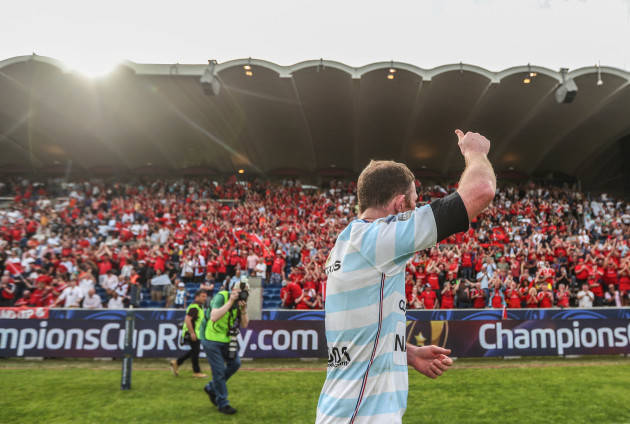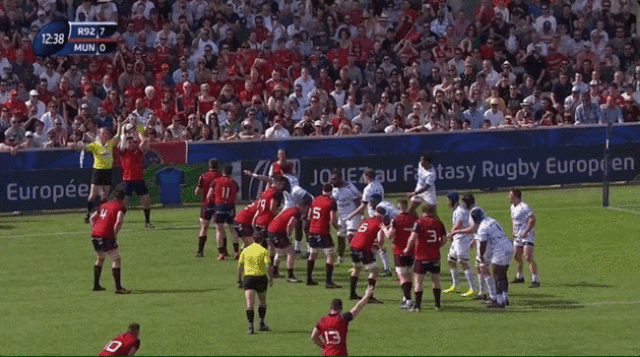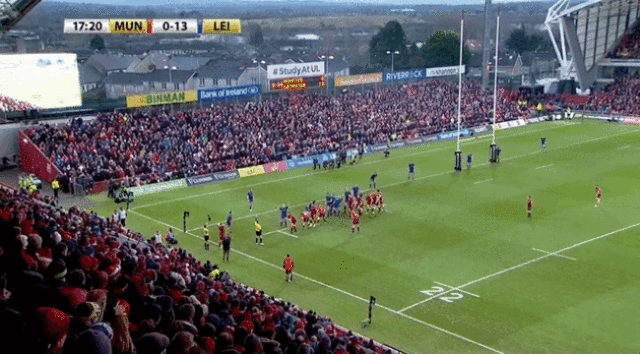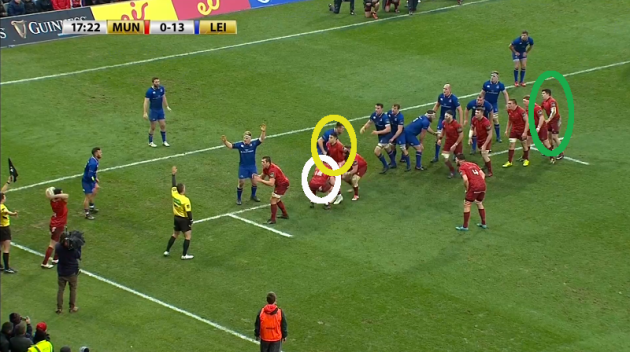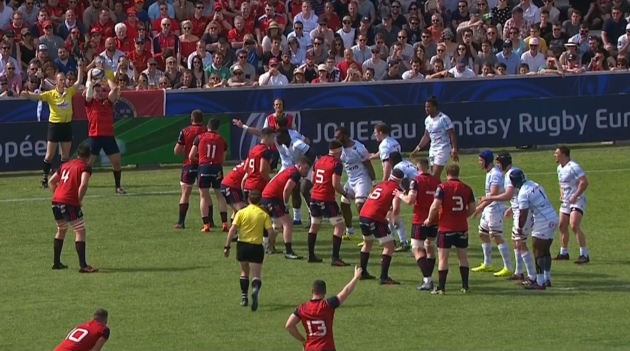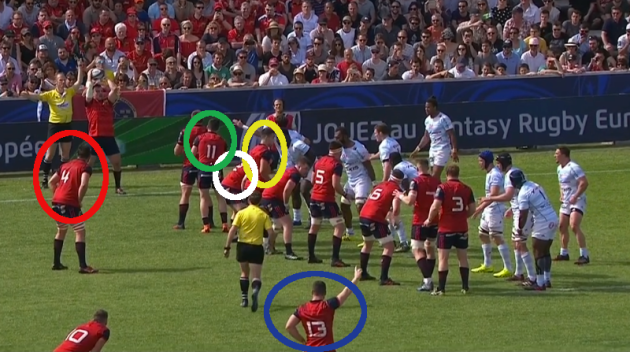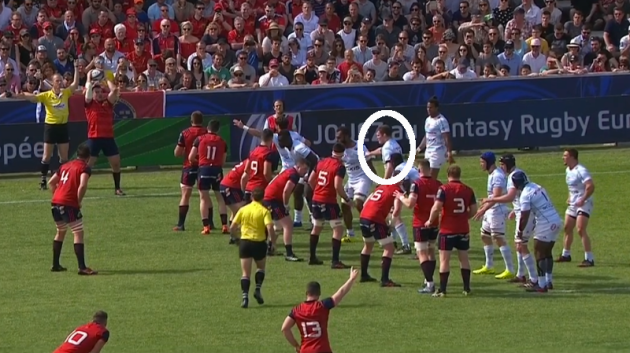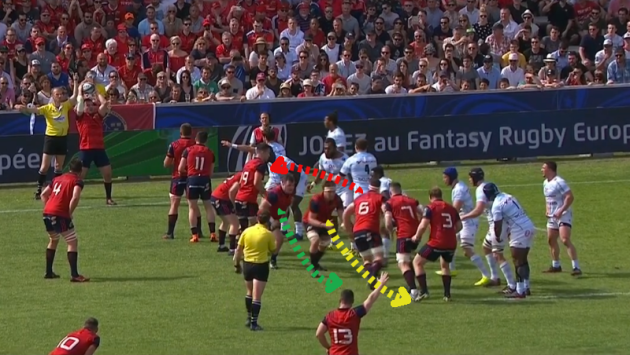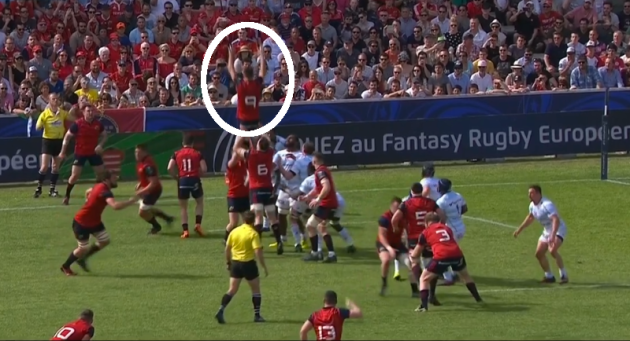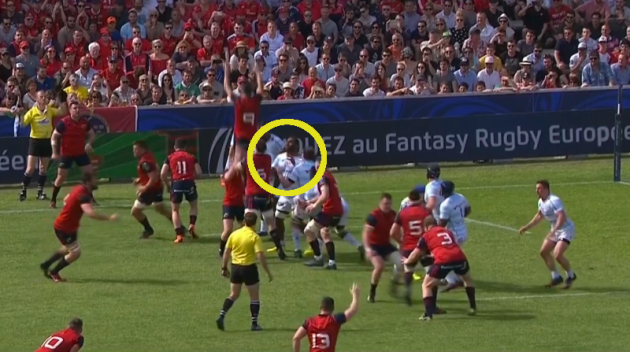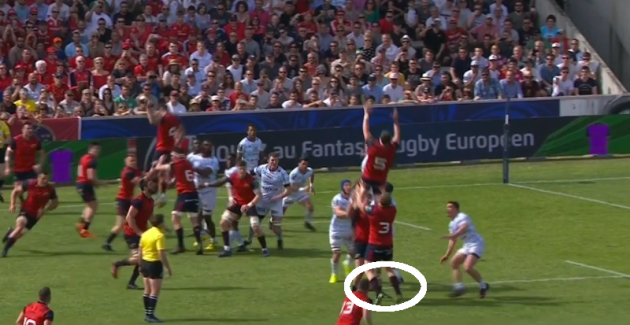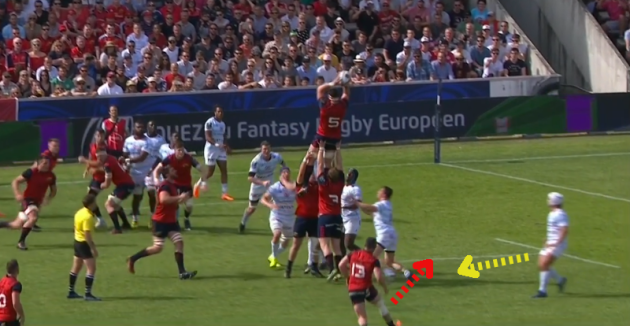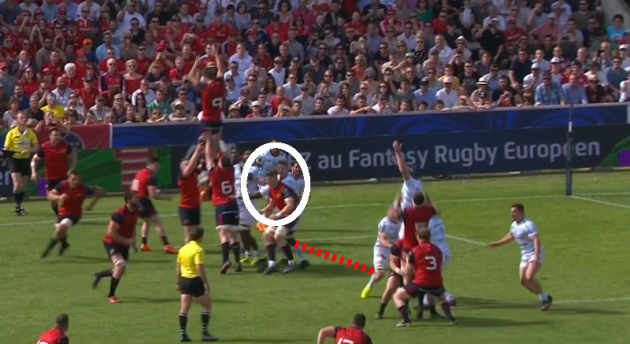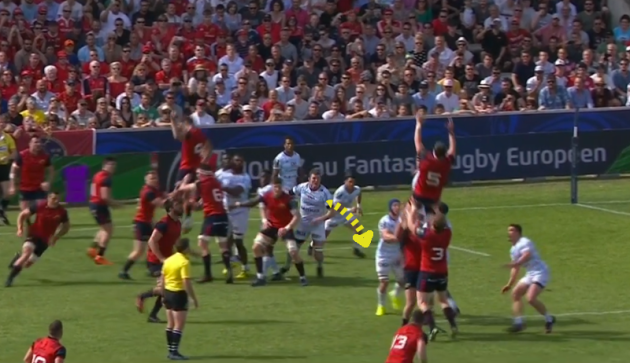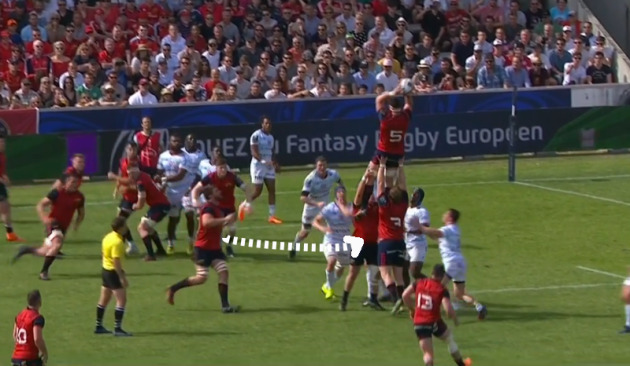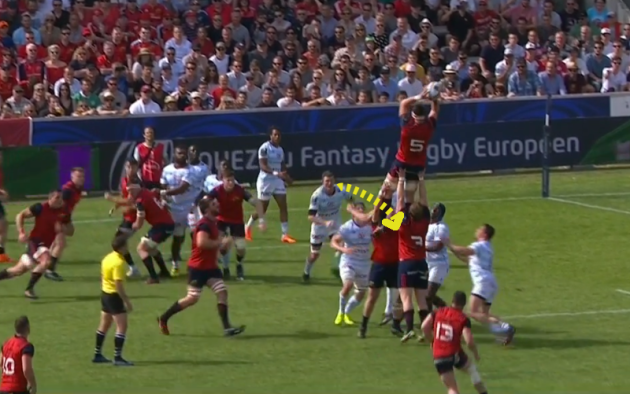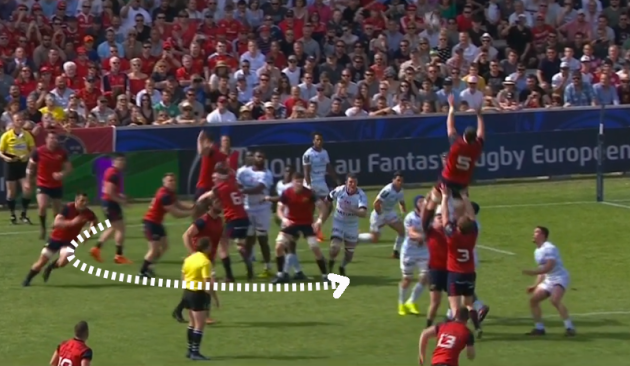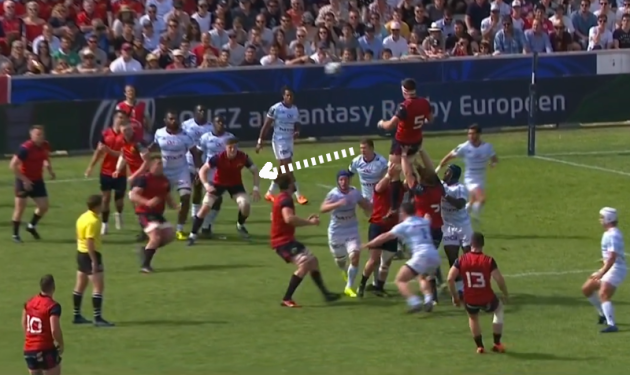LITTLE MOMENTS WIN big games and Donnacha Ryan is a player who tends to produce quite a few of them.
They’re not always the most glamorous impacts but the Tipperary second row has made a career out of being the kind of player that team-mates love to have alongside them.
The lineout is one area where Ryan invests a lot of time and energy.
The sheer amount of analysis that goes into this element of the game is a common trend in the professional game, as players – usually second rows – look for tiny advantages over the opposition.
Because opposition lineout analysis is so in-depth, there is also a huge amount of subterfuge and deception involved.
Sometimes traps are laid months in advance. One team knows the other will have been watching, analysing and predicting certain plays and moves – so they try to lure them in with something similar-looking before pouncing in a different area.
We saw a wonderful example of this yesterday in Stade Chaban Delmas, with Munster producing an extremely intelligent play only for Ryan to react superbly and deny them what might have been a pivotal try.
Munster are already 7-0 down when we join play in the 13th minute, but their scrum has earned them a lineout platform 10 metres out from the Racing tryline – a prime opportunity to bring themselves back into the game.
Having already failed with one trick lineout play down the five-metre channel, Niall Scannell stepping on the touchline after receiving the ball back from Peter O’Mahony, Munster throw another sharp play at Racing, but Ryan is onto them.
Click here if you cannot view the clip above
It might not look like it on first viewing, but Ryan probably saves a try for Racing with his actions here.
“I think if Racing didn’t have Donnacha in their lineout, CJ Stander scores in the first-half with that move through the middle of the line-out,” is how Munster wing Keith Earls put it.
“Donnacha’s work-rate, his knowledge and the little cues he’d pick up on, he got around and hit CJ.”
The lineout play from Munster is very intelligent and to understand it, we have to go all the way back to January, when they scored a try off a similar formation.
It’s scrum-half Conor Murray who jumps in the lineout against Leinster on this occasion, winning the ball in the air before scoring two phases later.
Click here if you cannot view the clip above
As we analysed at the time, Munster have nine players in their lineout against Leinster here, with backs Murray [yellow below], Rory Scannell [white] and Alex Wootton [green] joining their forwards.
Jean Kleyn [4] is the receiver just behind the lineout and after Murray wins the ball, lifted by inside centre Scannell and prop Dave Kilcoyne, he transfers the ball to Stander at the front of the lineout, where Kleyn latches on.
Kleyn and Stander almost make it to the tryline to score, only for Devin Toner to illegally stop them, but Murray does power over after one carry infield from his forwards.
Having played Munster in the pool stages later the same month, we can say with certainty that Ryan and Racing would have examined this lineout play in detail.
They would have reviewed it again in recent weeks in the build-up to the Champions Cup semi-final, aware that Munster could roll it out in Bordeaux.
Ryan, such a clever lineout technician, was also surely cognisant of the fact that Munster’s lineout caller, Billy Holland, and his team might tweak the move.
“Obviously, he knows us inside out and he knows what gets us going, possibly our weaknesses,” says Earls.
“Especially for the lineout, himself and Billy had massive mind games leading up to it. Donnacha was massive when he was with us, leading our lineout.”
Ryan’s analysis will have meant that when he saw this lineout formation in the 13th minute, his mind will instantly have been firing.
The formation is very similar to the one we saw against Leinster in January, but there is a slight tweak.
The same three Munster backs have joined the lineout.
We can see Scannell [white below] and Murray [yellow] in almost exactly the same positions.
Wootton [green], however, is now in front of them, rather than at the back of the lineout.
The rest of the formation is identical, with Kleyn [red] at receiver again.
We can see Munster centre Sammy Arnold [blue] signalling for the ball out in the Munster attacking line, looking to add any distraction he can for Racing.
We’ve highlighted Ryan in white in the Racing lineout below, and he and his side have plenty to consider.
Do they jump to compete with Murray, predicting the scrum-half will be the lineout target?
Do they predict Munster are bluffing and instead focus their attention on competing at the tail of the lineout?
If Murray wins the ball at the front, how can they stop that mini-maul at the front formed by Stander, Kleyn and now Wootton?
Munster’s tweaks involve a lot more movement before the lineout catch.
Peter O’Mahony [red below] moves towards the front of the lineout, in order to present himself as the back lifter for Murray.
Meanwhile, Holland [yellow above] moves towards the rear of the lineout in order to jump there.
Dave Kilcoyne [green] moves with Holland in order to present himself as the front lifter in that new pod at the back of the lineout, with Stephen Archer [3] already in place to lift at the back of Holland.
O’Mahony’s movement sees him lifting at the back of Murray as the scrum-half jumps, with midfielder Scannell lifting at the front.
Murray isn’t the true target for Munster here, but it’s obvious what they’re hoping will happen as he does go up here.
Niall Scannell’s throw is destined for the pod at the back of the Munster lineout, so if Ryan and the other Racing forwards at the front jump to compete with Murray and don’t win the ball, that’s a big advantage for Munster.
Even as they stay down, it’s clear how the Racing players at the front of the lineout are initially drawn into where Murray jumps, ready to engage in a maul or deal with Kleyn arriving to latch onto Stander after a transfer.
Scannell’s excellent throw clears the front pod and flies towards Munster’s reorganised pod at the back, where Holland has jumped in between the lifts of props Kilcoyne and Archer.
It’s worth noting that Munster have deliberately stepped out beyond the 15-metre line here.
Doing so means the lineout has technically ended and Racing’s defensive line can now advance up, having initially started 10 metres back in order to be onside.
Munster want Racing to race up hard here [as indicated in yellow below], with Arnold’s hard line from midfield [red] contributing to this intention to lure them up.
Munster are hoping Racing won’t have any players capable of moving across in behind the lineout in reaction to what is to come.
The Racing pod at the back of the lineout jumps to compete with Holland, again something Munster want as it leaves the French side with fewer players in position to react to their planned redirection.
Jack O’Donoghue has made a movement in the lineout before the throw, echoing O’Mahony’s shift towards the front.
The Munster back row is circled in white below.
O’Donoghue isn’t part of the pod at the front and is instead attempting to subtly block off Racing’s front pod if they react and turn.
O’Donoghue is doing his best to preserve the space we have indicated with the red line in the shot above, which has been left vacated by Munster’s rear pod moving out beyond the 15-metre line.
Ryan has read that Murray’s jump is a dummy one, however, and we can see him reacting in the shot below.
Ryan is bouncing around O’Donoghue, as indicated in yellow, towards that rear Munster pod.
Munster’s subterfuge isn’t finished just yet, with Kleyn moving from his starting position as the receiver towards Holland’s jump [white below].
Kleyn’s movement makes it look like Munster are going to set up a maul around Holland as soon as he lands to ground with the ball.
The temptation for Ryan now is to accelerate across towards that Munster pod and engage aggressively to counter the possible maul [yellow below].
Kleyn’s movement and the fact that Munster are out over the 15-metre line draws Racing’s defensive receiver, Camille Chat, up and around the rear pod, as indicated in red below.
Again, this is playing into Munster’s hands by leaving that space in behind the lineout a little barer.
But Ryan is still wary.
With movement all around him and an apparent threat of Munster forming a maul around Holland’s jump, Ryan still manages to stay calm and keep his options open.
The key strike runner for Munster is Stander.
The Munster number eight comes all the way from the very front of the lineout, arriving late and hidden to thunder onto the pop down off the top from Holland.
Munster are hoping that Stander will burst into clear space but Ryan is lying in wait.
It’s important to note that Racing scrum-half Maxime Machenaud [white below] has also come from the front of the lineout and is in behind Ryan here.
But even with Machenaud’s physical qualities, Stander would have backed himself in a clear one-on-one, with space on either side of the scrum-half, and moving at such speed this close to the tryline, particularly given that Machenaud has slightly over-read the play and would have to readjust to tackle Stander.
Machenaud isn’t required at all, however, with Ryan having resisted the temptation to over-commit towards Holland and instead kept himself alive in that space between Munster’s two pods.
It means that when Stander receives the ball from Holland, Ryan can instantly slam into him and wrestle him to the ground to kill Munster’s intelligent lineout play in a flash.
Presumably inspired by the All Blacks’ famous ‘Teabag’ move from the 2011 World Cup final, but utilising the involvement of three backline players and their own previous success with Murray jumping, it’s clever play from Munster.
But Ryan is up to the task and his typically important contribution makes a big difference.
It only counts as a single tackle on his stats sheet, but given the time on the match clock, the score and what we know followed, it’s much more than that.
The Munster lineout was thwarted on this occasion and things only got worse as their European dream died.
The42 is on Instagram! Tap the button below on your phone to follow us!
